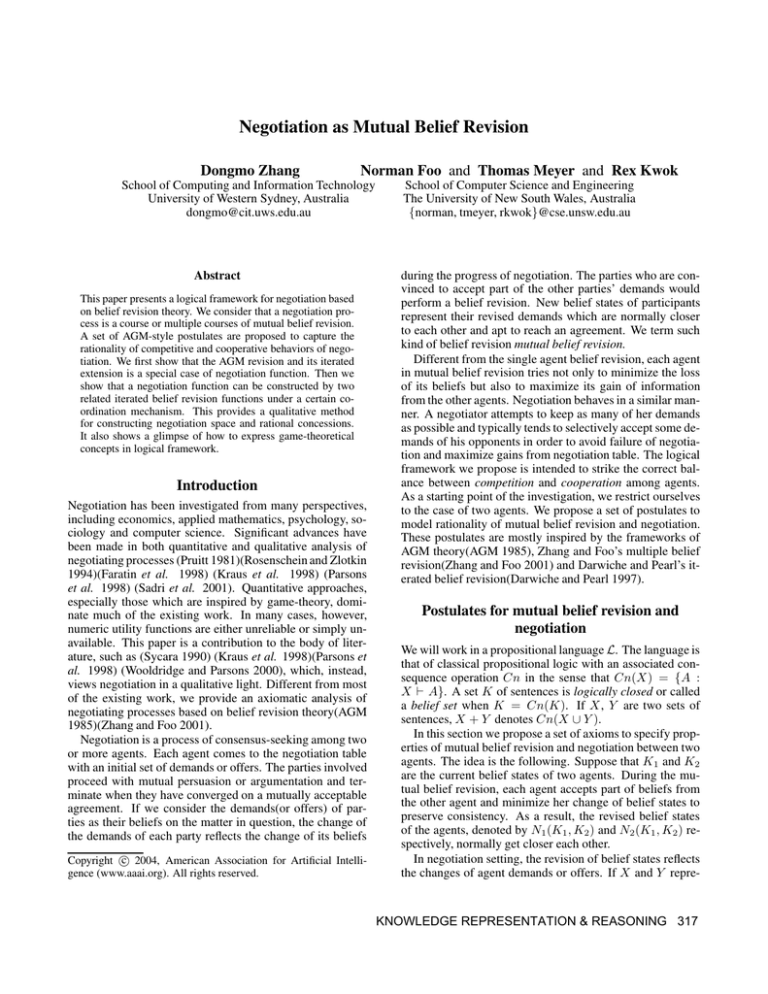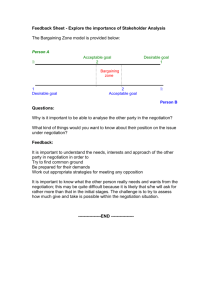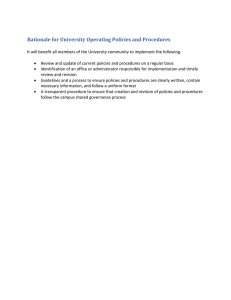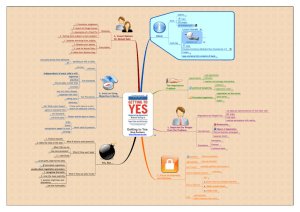
Negotiation as Mutual Belief Revision
Dongmo Zhang
Norman Foo and Thomas Meyer and Rex Kwok
School of Computing and Information Technology
University of Western Sydney, Australia
dongmo@cit.uws.edu.au
Abstract
This paper presents a logical framework for negotiation based
on belief revision theory. We consider that a negotiation process is a course or multiple courses of mutual belief revision.
A set of AGM-style postulates are proposed to capture the
rationality of competitive and cooperative behaviors of negotiation. We first show that the AGM revision and its iterated
extension is a special case of negotiation function. Then we
show that a negotiation function can be constructed by two
related iterated belief revision functions under a certain coordination mechanism. This provides a qualitative method
for constructing negotiation space and rational concessions.
It also shows a glimpse of how to express game-theoretical
concepts in logical framework.
Introduction
Negotiation has been investigated from many perspectives,
including economics, applied mathematics, psychology, sociology and computer science. Significant advances have
been made in both quantitative and qualitative analysis of
negotiating processes (Pruitt 1981)(Rosenschein and Zlotkin
1994)(Faratin et al. 1998) (Kraus et al. 1998) (Parsons
et al. 1998) (Sadri et al. 2001). Quantitative approaches,
especially those which are inspired by game-theory, dominate much of the existing work. In many cases, however,
numeric utility functions are either unreliable or simply unavailable. This paper is a contribution to the body of literature, such as (Sycara 1990) (Kraus et al. 1998)(Parsons et
al. 1998) (Wooldridge and Parsons 2000), which, instead,
views negotiation in a qualitative light. Different from most
of the existing work, we provide an axiomatic analysis of
negotiating processes based on belief revision theory(AGM
1985)(Zhang and Foo 2001).
Negotiation is a process of consensus-seeking among two
or more agents. Each agent comes to the negotiation table
with an initial set of demands or offers. The parties involved
proceed with mutual persuasion or argumentation and terminate when they have converged on a mutually acceptable
agreement. If we consider the demands(or offers) of parties as their beliefs on the matter in question, the change of
the demands of each party reflects the change of its beliefs
c 2004, American Association for Artificial IntelliCopyright gence (www.aaai.org). All rights reserved.
School of Computer Science and Engineering
The University of New South Wales, Australia
{norman, tmeyer, rkwok}@cse.unsw.edu.au
during the progress of negotiation. The parties who are convinced to accept part of the other parties’ demands would
perform a belief revision. New belief states of participants
represent their revised demands which are normally closer
to each other and apt to reach an agreement. We term such
kind of belief revision mutual belief revision.
Different from the single agent belief revision, each agent
in mutual belief revision tries not only to minimize the loss
of its beliefs but also to maximize its gain of information
from the other agents. Negotiation behaves in a similar manner. A negotiator attempts to keep as many of her demands
as possible and typically tends to selectively accept some demands of his opponents in order to avoid failure of negotiation and maximize gains from negotiation table. The logical
framework we propose is intended to strike the correct balance between competition and cooperation among agents.
As a starting point of the investigation, we restrict ourselves
to the case of two agents. We propose a set of postulates to
model rationality of mutual belief revision and negotiation.
These postulates are mostly inspired by the frameworks of
AGM theory(AGM 1985), Zhang and Foo’s multiple belief
revision(Zhang and Foo 2001) and Darwiche and Pearl’s iterated belief revision(Darwiche and Pearl 1997).
Postulates for mutual belief revision and
negotiation
We will work in a propositional language L. The language is
that of classical propositional logic with an associated consequence operation Cn in the sense that Cn(X) = {A :
X ` A}. A set K of sentences is logically closed or called
a belief set when K = Cn(K). If X, Y are two sets of
sentences, X + Y denotes Cn(X ∪ Y ).
In this section we propose a set of axioms to specify properties of mutual belief revision and negotiation between two
agents. The idea is the following. Suppose that K1 and K2
are the current belief states of two agents. During the mutual belief revision, each agent accepts part of beliefs from
the other agent and minimize her change of belief states to
preserve consistency. As a result, the revised belief states
of the agents, denoted by N1 (K1 , K2 ) and N2 (K1 , K2 ) respectively, normally get closer each other.
In negotiation setting, the revision of belief states reflects
the changes of agent demands or offers. If X and Y repre-
KNOWLEDGE REPRESENTATION & REASONING 317
sent the initial demands/offers of two agents, N1 (X, Y ) and
N2 (X, Y ) will be their revised demands/offers after negotiation. N1 (X, Y ) ∩ N2 (X, Y ) will be then the agreement
reached in the negotiation.
Formally, a mutual revision or negotiation function is a
two-input and two-output function
N (X, Y ) = (N1 (X, Y ), N2 (X, Y ))
where X and Y represent the initial belief sets or demands of
each agent and N1 (X, Y ) and N2 (X, Y ) the revised belief
sets or demands, respectively. Note that we do not assume
that X or Y to be logically closed.
Definition 1 A function N : 2L × 2L → 2L × 2L is a
mutual belief revision or negotiation function if it satisfies
the following postulates:
(N1) Closure:
N1 (X, Y ) = Cn(N1 (X, Y )); N2 (X, Y ) = Cn(N2 (X, Y ))
(N2) Inclusion:
N1 (X, Y ) ⊆ X + Y ; N2 (X, Y ) ⊆ X + Y
(N3) Vacuity: If X ∪ Y is consistent, then
X + Y ⊆ N1 (X, Y ); X + Y ⊆ N2 (X, Y )
(N4) Inconsistency:
N1 (X, Y ) is inconsistent iff X or Y is inconsistent;
N2 (X, Y ) is inconsistent iff X or Y is inconsistent.
(N5) Extensionality: If Cn(X) = Cn(Y ), then
N (X, Z) = N (Y, Z); N (Z, X) = N (Z, Y )
We call (N1)-(N5) the basic postulates for mutual belief
revision or negotiation. Intuitively, (N1) says that the resulting belief state of each agent is logically closed. (N2)
states that no third party information would be introduced.
(N3) says that each agent will accept all the beliefs of the
other agent if no conflict arises. (N4) says that mutual belief
revision can only happen between rational agents. (N5) assumes that mutual belief revision is syntax-independent, i.e.
logically equivalent description of beliefs leads to the same
results of mutual belief revision.
Similar interpretation of these postulates can also be given
in terms of negotiation. If we localize the belief state of an
agent on the matters of a negotiation, its belief set represents its demands in the negotiation, which we call the demand sets of the agents. (N1) then states that each negotiator should be aware of that she is responsible to undertake
all the items and their consequences of her demands once
they are included in an agreement. (N2) assumes that if no
conflicts between the demands of two agents, amendments
of demands may only be done within the initial demand sets
from the negotiators1. (N3) reflects the cooperative aspect
of negotiation that each agent is willing to accept the other
party’s demands provided they do not conflict with herself’s.
(N4) means that no negotiation can proceed from inconsistent demands. (N5) is similar.
1
Note that if there are conflicts between two agents’ demands,
the amended demand sets could be anything since X + Y will be
inconsistent.
318
KNOWLEDGE REPRESENTATION & REASONING
It is easy to see that postulates (N1)-(N5) are counterparts
of AGM basic postulates for belief revision(AGM 1985)(see
next section for a review of the postulates) except of the success postulate. It is unreasonable to assume that one side of
negotiation would accept all the demands of the other side.
It is easy to see that for the following two special cases:
• X ∪ Y is consistent. In this case, N (X, Y ) = (X + Y, X + Y );
• X or Y is inconsistent. In this case, N (X, Y ) = (L, L).
the basic postulates can uniquely determine a negotiation
function. However for the most interesting cases when X
and Y are consistent but X ∪ Y is inconsistent, the postulates do not tell us too much about what the function would
be. We need more postulates to capture more characteristics
of negotiation behaviors. The following two postulates reflect a common principle in belief revision and negotiation,
known as the principle of information economy, from two
different perspectives: competitive and cooperative.
(N6) Consistent Expansion:
If X ∪ N1 (X, Y ) is consistent, then X ⊆ N1 (X, Y );
If Y ∪ N2 (X, Y ) is consistent, then Y ⊆ N2 (X, Y ).
This postulate capture the conservative or self-interest
feature of agents, which says that if an agent is not going
to accept any counter-demands that contradict her own, she
does not need to give up any of her demands. The postulate
comes from Ferme and Hansson’s selective revision (Ferme
and Hansson 1999), where the postulate was interpreted as
”previous beliefs are given up only if this is required to avoid
inconsistency”.
The following postulate (N7) reflects the cooperative attitude of negotiation agents. It states that every agent should
commit herself to keeping her original demands/offers once
they have been are accepted by the other side. We call it the
rule of no recantation. It is a quite common negotiation protocol and is one of conditions to guarantee the convergency
of negotiation process. To understand the postulate, note
that Cn(X) ∩ N2 (X, Y ) represents the demands of agent 1
which have been accepted by agent 2 after negotiation and
Cn(Y )∩N1 (X, Y ) the demands of agent 2 which have been
accepted by agent 1.
(N7) No Recantation:
Cn(Y ) ∩ N1 (X, Y ) ⊆ N2 (X, Y );
Cn(X) ∩ N2 (X, Y ) ⊆ N1 (X, Y ).
We remark that (N7) does not imply the following condition:
Intersection: K1 ∩ K2 ⊆ N1 (K1 , K2 ) ∩ N2 (K1 , K2 )
which says that common items of initial demands must be
included in the last agreement of the negotiation. This condition can be a special negotiation protocol but we can’t take
it for granted. If both sides decide to give up a common item
(in order to keep some more beneficial demands), the item
will not be included in the last agreement.
The following postulate describes a property of iterated
process of negotiation.
(N8) Iteration:
If F ⊆Cn(Y )∩N1 (X, Y ), then N (N1 (X, F ),Y )=N (X, Y ).
If F ⊆Cn(X)∩N2 (X, Y ), then N (X, N2 (F, Y ))=N (X, Y ).
It is a typical strategy in real-life negotiation that a negotiator poses its demands in several stages. At each stage,
the negotiator reveals part of her demands, hiding something
tougher or some alternatives behind tying to push her opponent changing mind step by step. (N8) says that if one can
expect that some of her demands will be definitely accepted
by the other side, it will be useless to pose this part first. As
we will see, this postulate posts a constraint on the stability
of agent’s negotiation policy.
Multiple belief revision and iterated belief
revision
We have seen in the last section that there exists a close relationship between AGM belief revision and mutual belief revision. In this section we show that an AGM revision function is a special case of mutual belief revision. First let’s
recall some basic facts about multiple belief revision and iterated belief revision in single agent environments.
To best suit the context of mutual belief revision, instead
of using the original AGM framework, we shall exploit the
multiple version of the AGM theory (Zhang and Foo 2001),
which allows us to revise a belief set by another belief set.
Formally, for any belief set K and a set F of sentences,
K ⊗ F stands for the result of belief revision when K is
revised by F . The operation is required to satisfy the following postulates:
(⊗1) K ⊗ F = Cn(K ⊗ F ).
(⊗2) F ⊆ K ⊗ F .
(⊗3) K ⊗ F ⊆ K + F .
(⊗4) If F ∪ K is consistent, K + F ⊆ K ⊗ F .
(⊗5) K ⊗ F is inconsistent if F is inconsistent.
(⊗6) If Cn(F1 ) = Cn(F2 ), K ⊗ F1 = K ⊗ F2 .
(⊗7) K ⊗ (F1 ∪ F2 ) ⊆ (K ⊗ F1 ) + F2 .
(⊗8) If F2 ∪ (K ⊗ F1 ) is consistent, (K ⊗ F1 ) + F2 ⊆ K ⊗
(F1 ∪ F2 ).
exact AGM postulates. This should be fine because (⊗IBR)
goes well with AGM postulates(Zhang 2004).
Now let’s consider a special case of mutual belief revision
when one agent unconditionally accepts the other agent’s beliefs. Formally, a mutual revision function N is a masterslave revision if it satisfies
(M-S) X ⊆ N2 (X, Y ).
The condition says that the second agent (slave) always
accepts beliefs of the first agent (master) with no reservation. Interestingly the following observation shows that under protocol (N 7), the first agent can always keep its beliefs.
Lemma 1 Let N be a master-slave revision. If it satisfies
(N 7), then for any X and Y , X ⊆ N1 (X, Y ).
The following is the representation theorem for masterslave revision.
Theorem 2 Let N be a master-slave revision. If we define
def
a revision function ⊗ as K ⊗ F = N2 (F, K), then it satisfies the postulates (⊗1)-(⊗6). If N satisfies (N 8), then it
satisfies (⊗IBR).
Conversely, if ⊗ is an iterated belief revision function
which satisfies (⊗1)-(⊗6) and (⊗IBR), then the mutual belief revision function defined as follows satisfies (N1)-(N8)
and (M-S):
def
N (X, Y ) = (Cn(Y ) ⊗ X, Cn(Y ) ⊗ X).
This representation theorem shows that (N1)-(N8) plus
(M-S) fully specifies a master-slave revision function. Since
an iterated revision function always exists, this theorem also
shows the consistency of the postulates (N1)-(N8).
In the next section, we will present a general construction
of negotiation function, which will allow more “balanced”
negotiation.
Construction of negotiation functions
A negotiation process normally consists of several stages
of mutual belief revision. To simulate such a process, an
iterated mechanism of belief revision is required2. The following assumption has been accepted by several different
iterated belief revision formalisms:
In this section we provide a model for negotiation functions.
Firstly, we give a simple model of negotiation function that
satisfies the basic postulates for mutual belief revision and
negotiation.
(⊗IBR) (K ⊗ F1 ) ⊗ (F1 ∪ F2 ) = K ⊗ (F1 ∪ F2 )
A function t : 2L → 2L is called a belief transform if for
any set X of sentences,
1. t(X) is a belief set, i.e., t(X) = Cn(t(X)).
2. t(Cn(X)) = t(X).
3. if X is consistent, then t(X) is consistent.
It is easy to see that (⊗IBR) is the multiple version of
the postulate (C1) in (Darwiche and Pearl 1997). Based on
Lehmann’s observation (Theorem 1 in (Lehmann 1995)) we
can easily prove that (⊗1)-(⊗6) and (⊗IBR) implies (⊗7)
and (⊗8).
The following theorem is an easy generalization of
Lehmann’s consistency result presented in (Lehmann 1995).
Theorem 1 (⊗1)-(⊗ 6) are consistent with (⊗IBR).
In the following we will call a revision function an iterated belief revision if it satisfies the postulates (⊗1)-(⊗8)
and (⊗IBR). Note that such an iterated revision function is
different from Darwiche and Pearl’s one since we use the
2
This is similar to some other settings, say belief fusion
(Maynard-Reid II and Shoham 2001).
Representation theorem for basic postulates
Theorem 3 A negotiation function N satisfies the basic
postulates (N1)-(N5) if and only if there are two belief transforms t1 and t2
such that
(X + Y, X + Y ), if X ∪ Y is consistent;
(L, L),
if either X or Y
N (X, Y ) =
is inconsistent;
(t1 (X), t2 (Y )),
otherwise.
This theorem indicates that the basic postulates does not
tell us too much except that agents in a negotiation might
change their mind.
KNOWLEDGE REPRESENTATION & REASONING 319
Negotiable deals
Now we give a more sophisticated model to capture more
properties of negotiation processes. We shall introduce some
concepts that are borrowed from game-theory, inspired by
the work of (Rosenschein and Zlotkin 1994).
Let X and Y be two sets of sentences, representing the
initial demands or offers of two agents, respectively. We
call the pair (X, Y ) a negotiation encounter.
Given two iterated revision functions ⊗1 and ⊗2 . A deal
over an encounter (X, Y ) is a pair (Ψ1 , Ψ2 ) such that Ψ1 ⊆
Cn(X), Ψ2 ⊆ Cn(Y ) and satisfies the fix-point condition:
Cn(Ψ1 ∪ Ψ2 ) = (Cn(X) ⊗1 Ψ2 ) ∩ (Cn(Y ) ⊗2 Ψ1 ) (1)
The set of all possible deals over (X, Y ) is called the negotiation set of (X, Y ), denoted by N S(X, Y ).
Intuitively, Ψ1 represents all the demands of agent 1 that
agent 2 is willing to accept. Similarly Ψ2 expresses the demands of agent 2 that agent 1 is willing to accept. Then
Cn(X) ⊗1 Ψ2 is going to be the revised demand set of agent
1 and Cn(Y ) ⊗2 Ψ1 the revised demand set of agent 2 after negotiation. A deal then, is an agreement in which both
agents agree on Ψ1 and Ψ2 (as well as their consequences).
Therefore Cn(Ψ1 ∪Ψ2 ) will be the common acceptable conditions, (Cn(X) ⊗1 Ψ2 ) ∩ (Cn(Y ) ⊗2 Ψ1 ), after the negotiation. Negotiation set consists of all possible deals that both
agent might consider.
Obviously negotiation set can never be empty since
(Cn(X) ∩ Cn(Y ), Cn(X) ∩ Cn(Y )) always belongs to
N S(X, Y ). We call this deal the conflict deal of the encounter.
Example 1 Consider an encounter (X, Y ) where X =
{p, q} and Y = {¬p, ¬q}. Let ⊗1 and ⊗2 are any iterated revision functions. Then the conflict deal will be
(Cn({p ↔ q}), Cn({p ↔ q})), which is in the negotiation
set. Two other extreme cases, (Cn(X), Cn({p ↔ q})) and
(Cn({p ↔ q}), Cn(Y )), are also negotiable deals. If each
agent is going to take some offers from the other, then more
“balanced” negotiation could happen. However the result
will heavily depend on the evaluation on their demands and
counter-demands. Suppose that for agent 1, p is more entrenched than q and for agent 2 ¬q is more entrenched than
¬p. Then (Cn({p}), Cn({¬q})) will be a negotiable alternative whereas (Cn({q}), Cn({¬p})) is not. It seems to be that we are ready to define the negotiation
function as follows:
def
N (X, Y ) = (Cn(X) ⊗1 Ψ2 , Cn(Y ) ⊗2 Ψ1 )
where (Ψ1 , Ψ2 ) is a deal of (X, Y ). However, this is not
going to be a valid definition since we might have several
deals for each encounter. We need to pick up one deal from
all the possible deals as the agreement.
Selection function
We consider that negotiation is a decision-making procedure in which each agent chooses a deal from negotiation
set. If both agents choose the same deal, then an agreement is reached; otherwise, the conflict deal will be the result of the negotiation. Formally, a negotiation process is
320
KNOWLEDGE REPRESENTATION & REASONING
a selection function which chooses a deal from negotiation
set. Let γ be a selection function which selects an element
from a nonempty set. We will abbreviate γ(N S(X, Y )) to
γ(X, Y ). As usual, γi (X, Y ) means the ith component of
γ(X, Y ). Now we define a negotiation function as follows:
Definition 2 Let ⊗1 and ⊗2 be two iterated revision functions and γ a selection function. Define a negotiation function N as follows: for any encounter (X, Y ),
N (X, Y ) =
(X + Y, X + Y ),
if X ∪ Y is consistent;
(L, L),
if either X or Y
is inconsistent;
(Cn(X) ⊗1 Ψ2 , Cn(Y ) ⊗2 Ψ2 ), otherwise.
where (Ψ1 , Ψ2 ) = γ(X, Y ).
It is easy to see that given an encounter (X, Y ), if the
selection function γ selects the conflict deal of the encounter,
then N (X, Y ) = (X, Y ).
The following example shows another extreme case.
Example 2 Let ⊗ be an iterated revision operator and is the associated contraction operator. For any encounter
(X, Y ), let γ(X, Y ) = (Cn(X), Cn(Y ) X). Then γ is a
selection function that defines a master-slave mutual belief
revision operator where ⊗1 = ⊗2 = ⊗. Now let’s check whether the defined negotiation function
satisfies the proposed postulates. The following observation
is easy to verify.
Proposition 1 Any function that is defined by Definition 2
satisfies the basic postulates (N1)-(N5) as well as postulate
(N6).
However, To satisfy the other postulates we need to introduce some restrictions on the selection function.
Rationality and compatibility
A deal δ=(Ψ1 , Ψ2 ) over (X, Y ) is called rational if it satisfies the following conditions:
Cn(X) ∩ (Cn(Y ) ⊗2 Ψ1 ) ⊆ Cn(X) ⊗1 Ψ2
Cn(Y ) ∩ (Cn(X) ⊗1 Ψ2 ) ⊆ Cn(Y ) ⊗2 Ψ1
The set of all rational deals is called rational negotiation
set.
Obviously these conditions correspond to the postulation
(N7). Therefore if the function in Definition 2 defined by a
selection function over rational negotiation set, then it satisfies (N7).
(N8) requires a kind of uniformity in the selection mechanism over different negotiation situations. Before we present
the model for (N8), let’s introduce a game-theoretical concept.
A deal δ = (Ψ1 , Ψ2 ) dominates a deal δ 0 = (Ψ01 , Ψ02 )
if Cn(X) ⊗1 Ψ02 = Cn(X) ⊗1 Ψ2 and Cn(Y ) ⊗2 Ψ01 =
Cn(Y ) ⊗2 Ψ1 and either
Ψ01 ⊆ Ψ1 and Ψ02 ⊂ Ψ2 , or Ψ01 ⊂ Ψ1 and Ψ02 ⊆ Ψ2 .
In the other words, δ dominates δ 0 if at least one agent
agrees to accept more demands from the other agent without
sacrificing any agent’s profits.
A deal δ is called pareto optimal over a set of deals if it
is in the set and there do not exist any other deals in the set
that dominate δ.
not necessarily “fair”. We allow an agent totally give up her
beliefs and takes all information from the other agent.
Another stream of work is that of non-prioritized belief
The set of all the deals that are rational and pareto optimal
revision(Booth 2001)(Ferme and Hansson 1999)(Hansson
over the rational deals is called refined negotiation set.
1999)(Hansson et al. 2001). A negotiation function can
Lemma 2 Let (X, Y ) be any encounter. For any deal
be viewed as two associated selective revision(Ferme and
(Ψ1 , Ψ2 ) in the refined negotiation set,
Hansson 1999). A non-prioritized belief revision function
Ψ1 = Cn(X) ∩ (Cn(Y ) ⊗2 Ψ1 ) and Ψ2 = Cn(Y ) ∩
can also be defined by negotiation processes(Booth 2001).
(Cn(X) ⊗1 Ψ2 ).
However the existing operators proposed under these settings capture only the basic properties of negotiation.
Definition 3 A selection function γ is downward compatiThere have been several attempts to consider belief revible if for any F1 ⊆ γ1 (X, Y ) and F2 ⊆ γ2 (X, Y ),
γ(Cn(X)⊗1 F2 , Cn(Y )⊗2 F1 )=(γ1 (X, Y )+F2 , γ2 (X, Y )+F1 ). sion in the setting of multi-agent systems(Kfir-Dahav and
Tennenholtz 1996)(Malheiro et al. 1994)(van der Meyden
Example 3 Let γ be a selection function such that
1994). In (van der Meyden 1994) a concept of mutual beγ(X, Y ) = (Cn(X) ∩ Cn(Y ), Cn(X) ∩ Cn(Y )). Then γ
lief revision was defined with a totally different setting from
is downward compatible. In other wards, always-standingours, where mutual belief revision is referred to the process
still is a uniform behavior of negotiation.
of belief change by which an agent in a synchronous multiagent system revises its beliefs about other agents’ beliefs.
Now we come to the main result of the paper.
In terms of logical approach to negotiation, there are
Theorem 4 If γ is a downward compatible selection funcnumbers of researches on argumentation-based negotiation over a refined negotiation set, the negotiation function
tion(Sycara 1990)(Kraus et al.
1998)(Parsons et al.
defined by Definition 2 satisfies (N1)-(N8).
1998)(Sadri et al. 2001). This work is more concentrated
on agent architectures and procedural analysis of negotiaSince a downward compatible selection function always
tion protocols. Although the goal is similar with ours, the
exists, this theorem shows again the consistency of the neemphases and outcomes of the research are quite different
gotiation postulates. We remark that downward compatibilfrom our work ( we focus on the axiomatic analysis on neity is a sufficient condition for postulate (N8) but not necesgotiation processes).
sary. In fact, we can show that any master-slave negotiation
function satisfies postulate (N8) but its associated selection
function is not necessarily downward compatible. How to
Conclusion
find a sufficient and necessary condition for (N8) is open for
In this paper we presented a formal framework for describthe future research.
ing and modelling rational negotiation behaviors. A set of
AGM-style postulates was presented. A representation theRelated work
orem is given for the basic postulates. The consistency of all
the list of postulates was also proved through an explicit conThere have been several streams of research which related
struction of negotiation function in which negotiation proto this work. One stream is the work on arbitration, becess was modelled by two related iterated belief revision oplief merging and knowledge fusion (Liberatore and Schaerf
erations. This model provided a logical method to analyze
1998)(Kfir-Dahav and Tennenholtz 1996)(Konieczny and
the competitive and cooperative behaviors of negotiation.
Pino Perez 1998). All these researches deal with conflicts
As an initial work towards an axiomatic approach to nebetween agents. With our framework, we can also define an
gotiation, we only presented the basic axiomatic system and
“arbitration” operator that satisfies most of Revesz’s postuits modelling in this paper. In a sequent paper, we will delates and Liberatore and Schaerf’s postulates for arbitration
fine a notion of preference-based negotiation and concenoperation(Liberatore and Schaerf 1998)(Revesz 1997).
trate on the construction of negotiation concessions and outProposition 2 Let N be a negotiation function. Define an
comes(Meyer et al. 2004). By then, more computation”arbitration operator” 4 as follows: for any belief set K1
friendly examples will be given. There are also many other
and K2 ,
things to be done. First of all, in this work, we only extended
K1 4 K2 = N1 (K1 , K2 ) ∩ N2 (K1 , K2 )
some basic game-theoretical concepts, such as individual rathen 4 satisfies Liberatore and Schaerf’s postulates (A1)tionality and Pareto optimality, into logical form and express
(A3)(A5)-(A6) for two-agent case(Liberatore and Schaerf
a particular equilibrium by using fix-point inference. How1998).3
ever, more profound mechanisms of cooperation and competition behind negotiation, especially the large amount of
However there is a fundamental difference between arbivariations of equilibrium concepts in game theory and ecotration and mutual belief revision or negotiation. An arbinomics, need to be investigated.
tration of two knowledge bases should be fair on both information resources, whereas an outcome of negotiation does
3
Note that 4 does not satisfy (A4) since the inconsistency of
K1 4 K2 does not require the inconsistency of both K1 and K2 .
However, we do not consider this to be a major difference between
arbitration and negotiation.
Proofs of Selected Theorems
Due to the limitation of space, we only list the proof of two main
theorems.
Proof of Theorem 2: The postulates (⊗1) and (⊗3)-(⊗6) are the
special case of the postulates (N1)-(N5), respectively. (⊗2) is im-
KNOWLEDGE REPRESENTATION & REASONING 321
plied by (M-S). To prove (⊗ IBR), we know that (K ⊗ F1 ) ⊗
(F1 ∪ F2 ) = N2 (F1 ∪ F2 , K ⊗ F1 ). Since F1 ⊆ F1 ∪ F2 ,
it follows from (M-S) that F1 ⊆ N2 (F1 ∪ F2 , K). Therefore F1 ⊆ (F1 ∪ F2 ) ∩ N2 (F1 ∪ F2 , K). By (N8) we yield
N2 (F1 ∪ F2 , N2 (F1 , K)) = N2 (F1 ∪ F2 , K) = K ⊗ (F1 ∪ F2 ).
Conversely, suppose that ⊗ satisfies (⊗1)-(⊗6) and (⊗IBR). It
is obvious that the defined negotiation function satisfies obviously
(N1)-(N5). (N6) is implies by (⊗2) and (⊗4). (N7) is trivial.
To prove (N8), assume F ⊆ Cn(Y ) ∩ N1 (X, Y ). Then
Cn(F ) X ⊆ Cn(F ) ⊆ N1 (X, Y ) = Cn(Y ) ⊗ X. Hence
N1 (N1 (X, F ), Y ) = Cn(Y )⊗N1 (X, F ) = Cn(Y )⊗(Cn(F )⊗
X) = Cn(Y ) ⊗ (X ∪ (Cn(F ) X)) = (Cn(Y ) ⊗ X) +
(Cn(F ) X) = Cn(Y ) ⊗ X = N1 (X, Y ). Similarly we have
N2 (N1 (X, F ), Y ) = N2 (X, Y ).
Again assume F
⊆ Cn(X) ∩ N2 (X, Y ).
Then
N1 (X, N2 (F, Y )) = N1 (X, Cn(Y )⊗F ) = (Cn(Y )⊗F )⊗X =
Cn(Y ) ⊗ (F ∪ X) = Cn(Y ) ⊗ X = N1 (X, Y ).
N2 (X, N2 (F, Y )) is exactly the same.
Therefore (N7) is
valid. Proof of Theorem 4:
We only need to verify (N8).
Assume that F
⊆
Cn(Y ) ∩ N1 (X, Y ).
Then
F ⊆ Cn(Y ) ∩ (Cn(X) ⊗1 γ2 (X, Y )). It follows from Lemma 2
that F ⊆ γ2 (X, Y ). According to the construction of negotiation
function, N1 (N1 (X, F ), Y ) = N1 (X, F )⊗1 γ2 (N1 (X, F ), Y ) =
(Cn(X) ⊗1 γ2 (X, F )) ⊗1 γ2 (Cn(X) ⊗1 γ2 (X, F ), Y ). Let
F2 = γ2 (X, F ). Thus F2 ⊆ Cn(F ) ⊆ γ2 (X, Y ). Since γ
is downwards compatible, we have γ2 (Cn(X) ⊗1 F2 , Y ) =
γ2 (X, Y ). Therefore N1 (N1 (X, F ), Y ) = (Cn(X) ⊗1 F2 ) ⊗1
γ2 (Cn(X) ⊗1 F2 , Y ) = (Cn(X) ⊗1 F2 ) ⊗1 γ2 (X, Y ).
By (⊗IBR) we know (Cn(X) ⊗1 F2 ) ⊗1 γ2 (X, Y ) =
Cn(X) ⊗1 γ2 (X, Y ) = N1 (X, Y ). Put them together we yield
N1 (N1 (X, F ), Y ) = N1 (X, Y ). For agent 2, similarly we have
N2 (N1 (X, F ), Y ) = Cn(Y ) ⊗2 γ1 (N1 (X, F ), Y ) = Cn(Y ) ⊗2
γ1 (Cn(X) ⊗1 γ2 (X, F ), Y ) = Cn(Y ) ⊗2 γ1 (Cn(X) ⊗1 F2 , Y ).
By the downward compatibility of γ, we have γ1 (Cn(X) ⊗1
F2 , Y ) = γ1 (X, Y ) + F2 . Since F2 ⊆ Cn(Y ) ⊗2 γ1 (X, Y ),
Therefore, Cn(Y ) ⊗2 (γ1 (X, Y ) + F2 ) = Cn(Y ) ⊗2 γ1 (X, Y ).
These give us N2 (N1 (X, F ), Y ) = Cn(Y )⊗2 (γ1 (X, Y )+F2 ) =
We have proved
Cn(Y ) ⊗2 γ1 (X, Y ) = N2 (X, Y ).
N (N1 (X, F ), Y ) = N (X, Y ). The other half of the postulate is symmetric. References
E. Alchourrón,P. Gärdenfors and Makinson, 1985. On the
logic of theory change: partial meet contraction and revision functions, Journal of Symbolic Logic, 50(2)(1985),
510-530.
R. Booth,2001. A negotiation-style framework for nonpriorised revision, TARK’01, 137-150.
A. Darwiche and J. Pearl, 1997. On the logic of iterated
belief revision. Artificial Intelligence, 89(1-2):1-29.
P. Faratin, C. Sierra and N. R. Jennings, 1998. Negotiation decision functions for autonomous agents, Robotics
and Autonomous Systems, 24(1998):159–182.
E. Ferm and S. O. Hansson,1999. Selective Revision, Studia Logica, 63 (3):331-342.
322
KNOWLEDGE REPRESENTATION & REASONING
S. O. Hansson, 1999. A survey of non-prioritized belief revision, Erkenntnis 50:413-427.
S. O. Hansson, E. Ferm, J. Cantwell, and M. Falappa, 2001.
Credibility-limited revision, Journal of Symbolic Logic,
66:1581-1596.
D. Lehmann, 1995. Belief revision, revised, IJCAI-95,
1534-1540.
W. Li , A logical framework for evolution of specification. in Programming Language and Systems, (ESOP’94),
Springer-Verlag, 394-408, 1994.
P. Liberatore and M. Schaerf, 1998. Arbitration (or How
to merge knowledge bases), IEEE Transactions on Knowledge and Data Engineering, 1(10):76-90.
N. E. Kfir-Dahav and M. Tennenholtz, 1996. Multi-agent
belief revision, TARK’96, 175-194.
S. Konieczny and R. Pino Perez, 1998. On the logic of
merging, KR-98, 488-498.
S.Kraus, K.Sycara, A.Evenchik, 1998. Reaching agreements through argumentation: a logical model and implementation, Artificial Intelligence, 104(1998), 1-69.
B. Malheiro, N. R. Jennings, and E. Oliveira, 1994. Belief
revision in multi-agent systems, ECAI-94, 294-298.
P. Maynard-Reid II and Y. Shoham, 2001. Belief fusion:
aggregating pedigreed belief states, Journal of Logic, Language and Information 10 (2):183-209.
R. van der Meyden, 1994. Mutual belief revision (Preliminary Report), KR’94, 595-606.
T. Meyer, N. Foo, R. Kwok and D. Zhang, Logical foundations of negotiation, in this proceedings.
S. Parsons, C. Sierra, N. Jennings, 1998. Agents that reason
and negotiate by arguing, Journal of Logic and Computation 8(3): 261-292.
D. G. Pruitt, 1981. Negotiation Behavour, Academic Press.
P. Z. Revesz, 1997. On the semantics of arbitration, International Journal of Algebra and Computation, 7(2):133160.
J. S. Rosenschein and G. Zlotkin, 1997. Rules of Encounter, MIT Press.
C. Sierra, N. R. Jennings, P. Noriega, and S. Parsons, 1997.
A framework for argumentation-based negotiation. ATAL97: 177-192.
F. Sadri, F.Toni, and P. Torroni, 2001. Dialogues for Negotiation: agent varietirs and dialogue sequences, n Proc.
ATAL-2001.
K. Sycara, Persuasive arguementation in negotiation, Theory and Decision, 28:203-242.
M. Wooldridge and S. Parsons, 2000. Languages for negotiation, in: ECAI2000, 393-400.
D. Zhang and N. Foo, 2001. Infinitary belief revision,Journal of Philosophical Logic, 30(6):525-570.
D. Zhang, 2004. Properties of iterated belief revision, in:
Proc. LPNMR-04.





